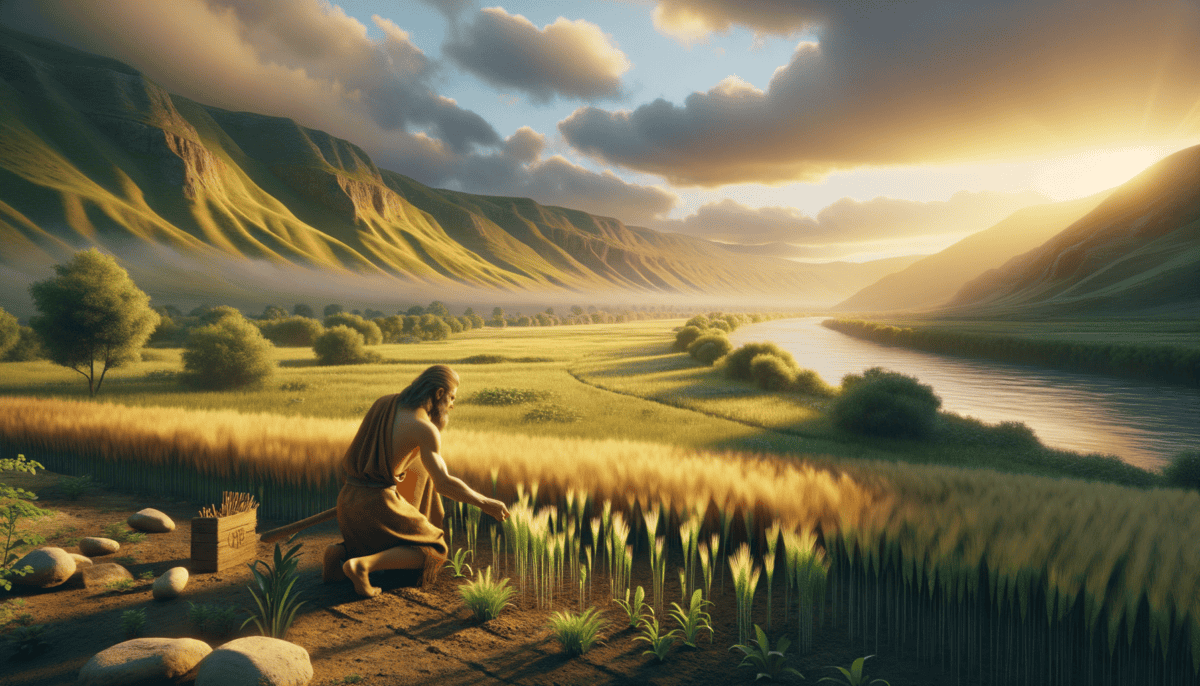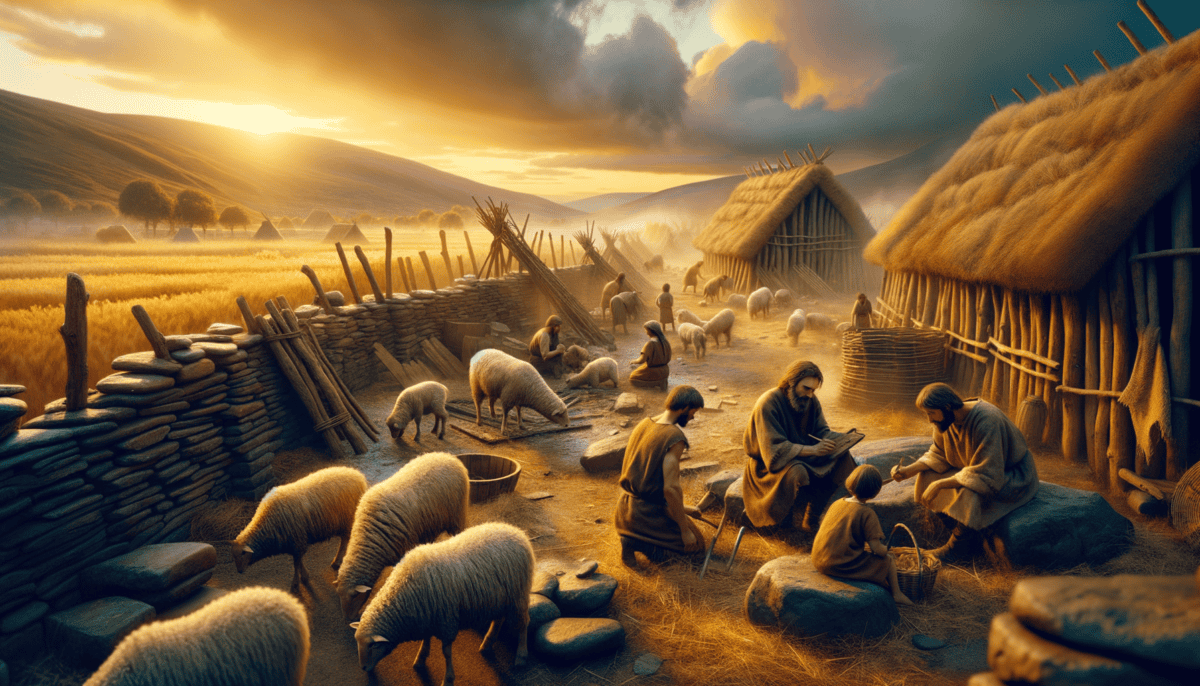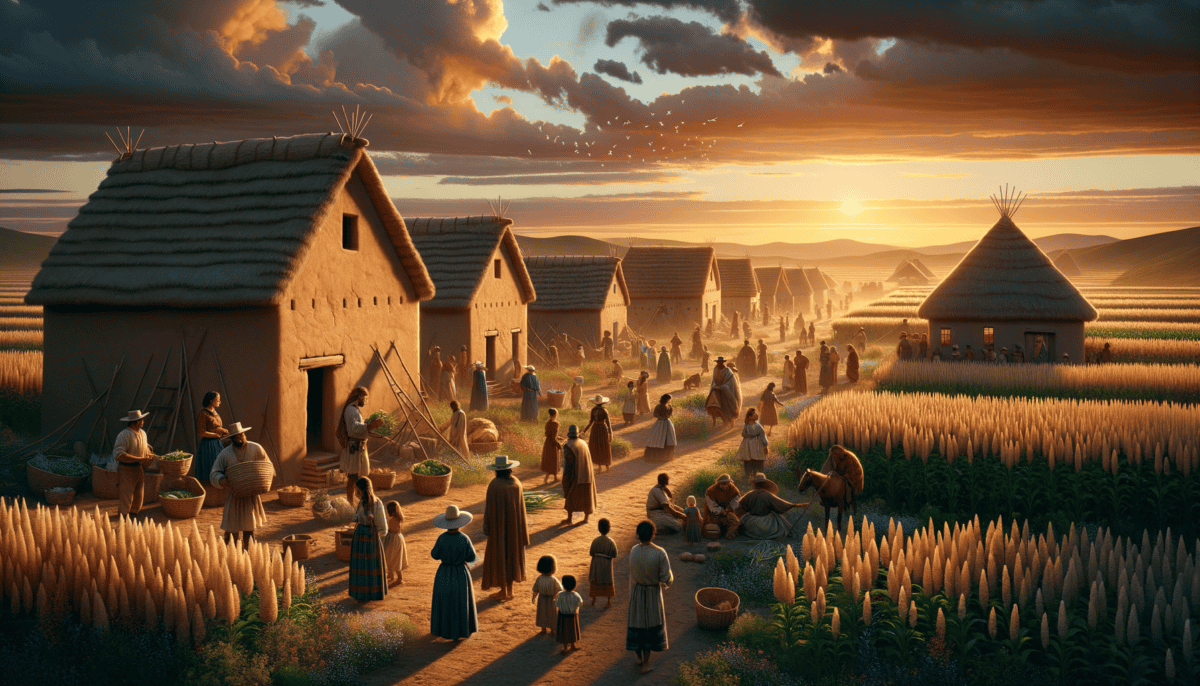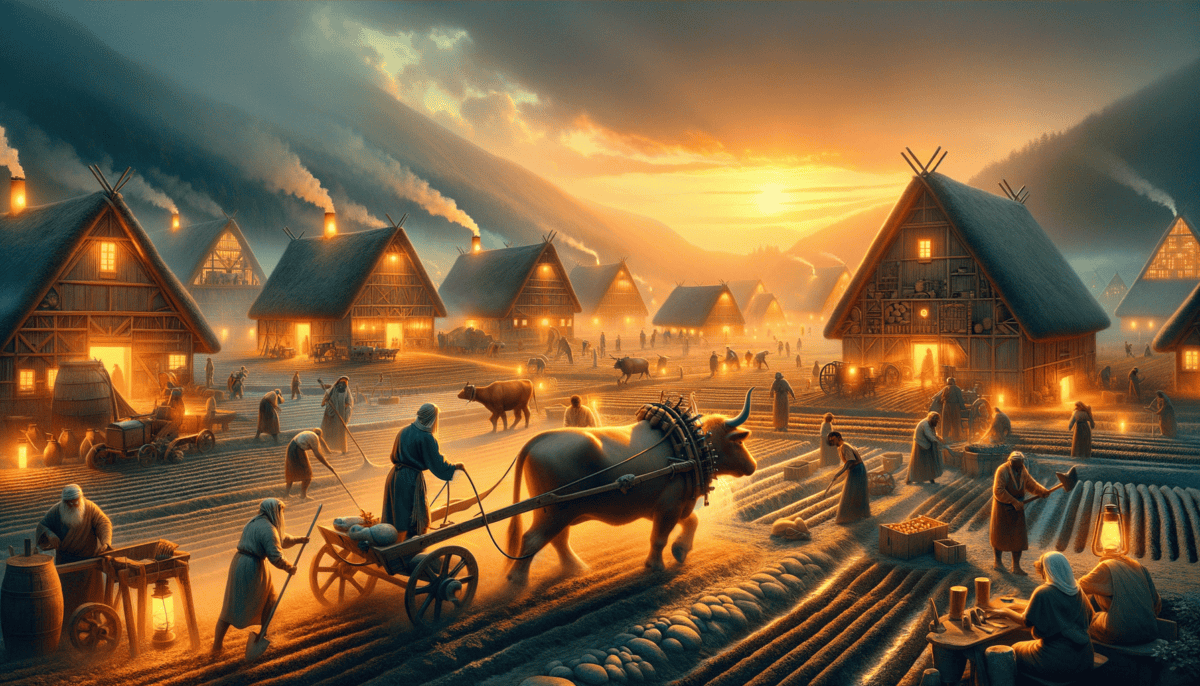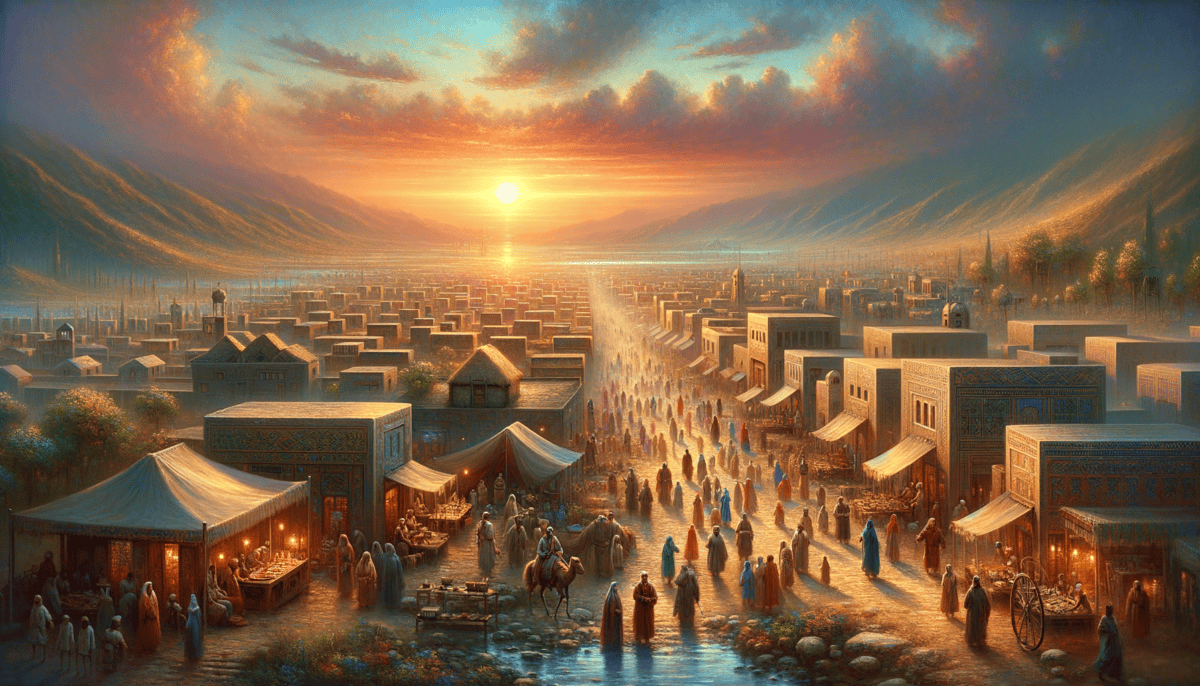The Wandering Life
Little Maya woke up as the morning sun peeked through the animal skin tent. The cool breeze made her snuggle deeper into her warm fur blanket.
"Time to move, little one," her mother Aria whispered, gently shaking her shoulder. "The berries are gone here. We must find new food."
Maya rubbed her sleepy eyes and watched her family pack their few belongings. They were always moving, following the animals and searching for food. That's what hunter-gatherers did – they went where the food was.
A Day of Gathering
"Look Maya!" her older brother Kai pointed excitedly. "Wild strawberries!"
Maya rushed over, her small hands carefully picking the red berries. Her mother had taught her which ones were safe to eat. They gathered nuts, berries, and roots in their woven baskets.
“Remember children,” Aria said, “take only what we need. Leave some for the animals and for new plants to grow.”
The Big Hunt
While Maya and her mother gathered plants, her father Tarek and Kai went hunting with the other men. They used sharp stone tools and spears to catch animals for food.
"The deer are moving north," Tarek explained at night around the fire. "We must follow them."
Living with Nature
Maya's family didn't have a permanent home. They moved with the seasons:
• Spring meant fresh berries and new leaves
• Summer brought plenty of fruits and fish
• Fall was time for nuts and seeds
• Winter meant following the big animals
Their life wasn't easy. Sometimes food was hard to find. They couldn't store much because they had to carry everything they owned. But Maya loved learning about nature from her parents.
Nighttime Stories
At night, the families gathered around warm fires. The elders told stories about the stars and animals. Maya loved these moments, cuddled between her mother and brother.
"The stars guide us," her grandmother would say. "They show us where to go, just as they showed our ancestors."
Always Moving
Maya's family traveled with other families. Together, they helped each other find food and stay safe. They made tools from stones and bones. They used animal skins for clothes and shelter.
"Why do we always move?" Maya asked one day.
"We follow the food, little one," her mother explained. "Just as the birds follow the warm weather. That's how we survive."
As Maya drifted to sleep that night, she wondered what tomorrow's journey would bring. Would they find sweet berries? Would her father catch a deer? Every day was different in their wandering life.
The stars twinkled above their tent, just as they had for thousands of years before. Tomorrow would bring another adventure, another place to explore, and new foods to find. That was the way of the hunter-gatherers, always moving, always searching, always learning from nature.
First Seeds of Change
Maya watched curiously as something unusual happened. Some of the seeds her mother had dropped near their camp last season had grown into tall plants!
“Mama, look!” Maya pointed excitedly. “The seeds we dropped made new plants!”
Aria knelt beside her daughter, examining the wheat stalks swaying in the breeze. This was different from their usual foraging spots. These plants had grown right where they had camped before.
A Special Discovery
“The seeds from our basket must have fallen here,” Aria said thoughtfully. “And now they’ve grown into food for us!”
Maya’s grandmother Sara joined them, her eyes wide with wonder. “This is special,” she said. “Instead of following the food, maybe the food can grow where we want it!”
Learning to Plant
The family decided to try something new. They carefully collected seeds from the best plants. Tarek helped clear a small patch of land near their camp.
“If we put seeds in the ground on purpose,” Aria explained to Maya, “we might be able to grow our own food.”
Maya helped push seeds into the soft soil. Her small hands patted the earth gently.
Watching and Waiting
Instead of moving on right away, the family stayed to watch their plants grow. Other families were curious and joined them. They planted different kinds of seeds:
• Wheat for making food
• Barley that grew strong and tall
• Peas that climbed up sticks
“How long until we see the plants?” Maya asked each morning.
“Patience, little one,” her mother smiled. “Nature has its own time.”
The First Harvest
Slowly, green shoots pushed through the soil. Maya checked on them every day, amazed at how they grew taller and stronger. When the plants turned golden, it was time to collect the grain.
“We made food grow!” Maya danced happily as they gathered their first harvest. “Can we do it again?”
A New Way of Life
More families began planting seeds. They built better shelters since they didn’t need to move as often. Maya loved having a special spot to call home.
“Why didn’t we always grow food?” she asked her grandmother.
“Sometimes the best ideas take time to discover,” Sara replied wisely. “Our people are learning new things every day.”
Sharing the Knowledge
Word spread about growing food. Travelers brought new kinds of seeds to try. Maya and her friends learned which plants grew best in different seasons.
They still gathered wild foods and hunted animals, but now they had their own crops too. It was the beginning of a big change in how people lived.
As Maya helped plant more seeds, she imagined all the food they would grow. The land around their camp was becoming a garden, and their wandering days were slowly turning into days of watching things grow.
Taming the Wild
Maya sat near the wheat field, watching a group of wild goats nibbling grass nearby. She noticed something interesting – some goats were less scared of people than others!
Making New Friends
“Look how that little goat keeps coming closer,” Maya whispered to her friend Kira. The smallest goat had woolly white fur and curious eyes.
Carefully, Maya held out some grain in her palm. The little goat took tiny steps forward, sniffing the air.
The Brave Little Goat
“I’ll call you Snowflake,” Maya smiled as the goat finally ate from her hand. Day after day, Snowflake returned, bringing other friendly goats too.
Tarek watched his daughter’s gentle way with the animals. “Maybe,” he said thoughtfully, “we could take care of these goats like we take care of our plants.”
“If we protect them from dangers, they might stay near our camp,” Aria added. “Then we’d always have milk and wool!”
Building Trust
The family built a simple fence using branches and vines. They left food and water for the friendliest goats. Soon, more animals began to trust them:
• Gentle goats that gave sweet milk
• Fluffy sheep with warm wool
• Curious piglets that followed Maya around
Learning Animal Ways
Maya loved watching the baby animals. She noticed how mothers took care of their babies and how the animals acted different in different seasons.
“The animals are like our garden,” she told her grandmother. “We help them grow, and they help us too!”
Growing Together
As their herd grew bigger, Maya’s family learned important things:
✨ Animals needed special food in winter
✨ Baby animals needed extra care
✨ Some animals were better at having babies than others
A Special Bond
Snowflake had babies of her own now. They were just as friendly as their mother. Maya helped feed them and kept them safe.
“These goats are part of our family now,” she said proudly, watching the kids play. “They trust us to take care of them.”
Sharing the Benefits
The animals brought many good things to the community:
Fresh milk every day
Warm wool for clothes
Strong animals to help carry things
New Discoveries
One day, Maya noticed something exciting. “Mama! The grass grows better where the goats have been!” The animal droppings were making the soil rich and helping their crops grow.
“Nature is clever,” Aria smiled. “Everything works together when we learn to pay attention.”
A Changing World
As seasons passed, more families started keeping animals. They shared what they learned about caring for different creatures. The village was becoming a busy place full of people, plants, and animals living together.
Maya sat with Snowflake under the evening sky, feeling proud of how far they’d come. Their world was changing, one friendly animal at a time.
A Place to Call Home
The sun peeked over the horizon as Maya watched her goats graze near their new home. Things were very different now that they didn’t move around all the time.
The First House
“Look what we built!” Maya exclaimed, touching the sturdy mud-brick walls of their house. It was much bigger than their old tent.
A Growing Village
More families were building houses nearby. Maya’s friend Kira lived just next door now. They had a special reason to stay in one place:
Their crops needed care every day
Their animals needed safe places to live
They could store food for winter
Working Together
Everyone helped build the new houses. Tarek and other strong adults carried heavy logs. Kids like Maya collected clay from the riverbank.
“When we work together, we can build amazing things!” Grandmother Aria said proudly.
Trading with Neighbors
New people started visiting their village. They brought exciting things to trade:
• Shiny stones from the mountains
• Shells from far-away waters
• Special tools made of hard rock
Village Life
Living in one place meant new jobs for everyone. Some people became really good at:
Making clay pots for storing food
Building stronger houses
Taking care of sick people
Making warm clothes from wool
Solving Problems Together
Maya noticed some challenges in their new way of life:
“The river is far from some houses,” she told her father. Together, they helped dig channels to bring water closer.
“We need a safe place for all our extra food,” Kira’s mother said. The village built a big storage building that everyone could use.
New Leaders Emerge
As the village grew bigger, they needed ways to make decisions. Wise elders like Grandmother Aria helped solve problems between neighbors.
Some people became leaders because they were good at:
Helping people work together
Making fair trades with visitors
Planning for the future
Celebrations and Community
The best part of village life was celebrating together. They had special gatherings to:
Welcome the spring planting
Celebrate the harvest
⭐ Share stories under the stars
Looking to Tomorrow
Maya loved watching her village grow. “Our home is more than just houses,” she told Snowflake one evening. “It’s all of us taking care of each other.”
Every day brought new ideas and ways to make their village better. People worked harder when they had a permanent home to care for. Little by little, their community grew stronger and more connected.
Tools of Change
Maya watched in amazement as her father tested something new in their wheat field. It was a wooden tool with a sharp stone edge – their very first plow!
The Amazing Plow
“Watch this, Maya!” her father called excitedly. He pushed the plow through the soil, making long straight lines. The earth split open easily, much better than digging with sticks.
Water Ways
Maya’s friend Kira had a clever idea too. She noticed how water flowed downhill and suggested they dig small channels to bring river water to their crops.
“If we can move the water where we want,” Kira explained, “our plants will grow better, even when it doesn’t rain!”
Water channels helped plants grow
Crops got water when needed
More food grew than ever before
Better Tools, Better Life
The village toolmaker was always trying new ideas:
• Stone hoes for breaking up soil
• Clay pots with special shapes for different foods
• Better grinding stones for making flour
Taking Care of the Soil
Grandmother Aria taught them something important about farming. “The soil gets tired,” she said. “We must let it rest sometimes and plant different crops each season.”
They learned to:
Switch what they planted each year
Let some fields rest
Use animal waste to make soil better
Plant beans to make the earth stronger
Working with Animals
Maya’s older brother had an idea. “What if we could get the oxen to pull the plow?” he suggested. After many tries, they succeeded!
Animals helped with heavy work
⚡ Farming became faster
They could grow more food
Sharing Knowledge
“Come see!” Maya called to visitors from other villages. She loved showing them their new farming tools. Soon, other communities started using these ideas too.
Growing Success
The new tools and methods worked so well that the village had more food than ever. Maya noticed how things were changing:
Bigger harvests than before
️ New storage buildings needed
More people moving to their village
Looking Forward
One evening, as Maya helped store the day’s harvest, she smiled at their progress. “We keep finding better ways to grow food,” she told Kira. “I wonder what we’ll discover next?”
Each new tool and idea made their lives a little easier. The village buzzed with excitement as people shared their discoveries and planned for tomorrow.
A World of Change
The morning sun rose over Maya’s village, now a bustling town filled with more people than she could count. Stone houses lined the streets, and the air buzzed with activity.
The Growing Town
“Look how big our home has grown!” Maya exclaimed to Kira as they walked through the busy marketplace. People traded wheat, tools, and colorful cloth at wooden stalls.
New Jobs for Everyone
People didn’t just farm anymore. Maya watched the busy workers:
Toolmakers making better plows
Bakers turning wheat into bread
Teachers sharing farming wisdom
Farmers growing more food than ever
Trading with Far Places
“Guess what came from the desert traders today?” Kira’s father showed them shiny stones and soft wool from distant lands.
People from far away brought exciting things to trade for their extra food and tools. The world seemed to grow bigger every day!
Writing Down Stories
Maya watched as the village elder pressed marks into wet clay. “These pictures help us remember important things,” he explained. “Like when to plant crops and how much food we have.”
Building Together
The whole community worked together to build:
• Big walls to protect their town
• Storage buildings for extra food
• Meeting places for everyone
• Wells for clean water
• Better roads between towns
Looking at Tomorrow
One evening, Maya sat with Grandmother Aria, watching the sunset over their thriving town. “When I was young,” Aria said, “we moved from place to place looking for food. Now look at what we’ve built!”
From tiny seeds, great things grew
People learned to work together
Villages became towns
Knowledge spread far and wide
A New Beginning
Maya looked at the twinkling lights of nearby towns. “We’ve learned so much,” she said. “And there’s still so much more to discover!”
As stars filled the sky, Maya dreamed of what tomorrow might bring. Their world had changed so much since that first seed was planted. And this was just the beginning of humanity’s great adventure.


